Thiamethoxam Sensing Using Gelatin Carbon Dots: Influence of Synthesis and Purification Methods
Abstract
1. Introduction
2. Materials and Methods
2.1. Chemical
2.2. Synthesis of CDs
| CDs-MF | Gelatin carbon dots prepared in a muffle furnace |
| CDs-MF-C | Gelatin carbon dots prepared in a muffle furnace + ultracentrifugation purification |
| CDs-MF-F | Gelatin carbon dots prepared in a muffle furnace + ultracentrifugation purification + syringe filter |
| CDs-MW | Gelatin carbon dots prepared in a domestic microwave |
2.2.1. Synthesis Methodology
2.2.2. Purification Procedure
2.3. CDs Characterization
2.4. Fluorescence Quantum Yield Measurements (ΦF)
2.5. Fluorescence Emissions of the CDs at Different pH Values
2.6. CDs Fluorescence Sensing TMX
2.7. Obtaining Analytical Parameters
2.8. Selectivity
2.9. Fluorescence Microscopy of CDs on Onion Endothelial Cells
3. Results and Discussion
3.1. Characterization of CDs
3.2. Optical Properties of the CDs
3.3. Fluorescent Sensing of TMX in Solution CDs
3.4. Fluorescence Quenching Mechanism of CDs by TMX
3.5. Fluorescence Microscopy of CDs on Onion Epidermal Cells
4. Conclusions
Supplementary Materials
Author Contributions
Funding
Institutional Review Board Statement
Informed Consent Statement
Data Availability Statement
Acknowledgments
Conflicts of Interest
References
- Xu, X.; Ray, R.; Gu, Y.; Ploehn, H.J.; Gearheart, L.; Raker, K.; Scrivens, W.A. Electrophoretic Analysis and Purification of Fluorescent Single-Walled Carbon Nanotube Fragments. J. Am. Chem. Soc. 2004, 126, 12736–12737. [Google Scholar] [CrossRef] [PubMed]
- Rooj, B.; Mandal, U. A Review on Characterization of Carbon Quantum Dots. Vietnam J. Chem. 2023, 61, 693–718. [Google Scholar] [CrossRef]
- Das, S.; Mondal, S.; Ghosh, D. Carbon Quantum Dots in Bioimaging and Biomedicines. Front. Bioeng. Biotechnol. 2023, 11, 1333752. [Google Scholar] [CrossRef]
- Yu, J.; Sun, X. Nitrogen-Doped Carbon Dots as Acid-Base Bifunctional and Efficient Catalysts for the Cycloaddition of CO2 with Epoxides. New J. Chem. 2024, 48, 4245–4252. [Google Scholar] [CrossRef]
- Ding, Y.; Li, X.; Zheng, Z.; Chen, M.; Zhang, Y.; Liu, Z.; Wang, F.; Guan, L. Preparation and Luminescent Modulation of Yellow Carbon Dots for Electroluminescent Device. J. Lumin. 2022, 249, 119036. [Google Scholar] [CrossRef]
- Singh, A.; Qu, Z.; Sharma, A.; Singh, M.; Tse, B.; Ostrikov, K.; Popat, A.; Sonar, P.; Kumeria, T. Ultra-Bright Green Carbon Dots with Excitation-Independent Fluorescence for Bioimaging. J. Nanostruct. Chem. 2023, 13, 377–387. [Google Scholar] [CrossRef]
- Li, M.; Chen, T.; Gooding, J.J.; Liu, J. Review of Carbon and Graphene Quantum Dots for Sensing. ACS Sens. 2019, 4, 1732–1748. [Google Scholar] [CrossRef]
- Fan, J.; Kang, L.; Cheng, X.; Liu, D.; Zhang, S. Biomass-Derived Carbon Dots and Their Sensing Applications. Nanomaterials 2022, 12, 4473. [Google Scholar] [CrossRef]
- Zhang, X.; Liao, X.; Hou, Y.; Jia, B.; Fu, L.; Jia, M.; Zhou, L.; Lu, J.; Kong, W. Recent Advances in Synthesis and Modification of Carbon Dots for Optical Sensing of Pesticides. J. Hazard. Mater. 2022, 422, 126881. [Google Scholar] [CrossRef]
- Preeti Nitin Joshi; Martin Khristi Synthesis of Carbon Dots from Leaf of Cynodon Dactylon (Grass). World J. Adv. Res. Rev. 2023, 17, 23–29. [CrossRef]
- Ochoa, D.; Torres, J.G.; Cervantes, E.M.; Cavazos, J.L.; Gómez, I. The Effect of Sonication on the Photoluminescence Property of Carbon Quantum Dots Synthesized by Hydrothermal Route. Dig. J. Nanomater. Biostruct 2024, 19, 319–325. [Google Scholar] [CrossRef]
- Han, L.; Guo, Y.; Zhang, H.; Wang, Z.; Zhang, F.; Wang, Y.; Li, X.; Wang, Y.; Ye, J. Preparation of Carbon Quantum Dot Fluorescent Probe from Waste Fruit Peel and Its Use for the Detection of Dopamine. RSC Adv. 2024, 14, 12345–12352. [Google Scholar] [CrossRef]
- Caetano, M.M.; Becceneri, A.B.; Ferreira, M.V.; Assunção, R.M.N.; da Silva, R.S.; de Lima, R.G. Carbonized Polymer Dots: Influence of the Carbon Nanoparticle Structure on Cell Biocompatibility. ACS Omega 2024, 9, 38864–38877. [Google Scholar] [CrossRef]
- Rai, D.; Jaiswal, Y.; Sinha, S. Graphene Quantum Dots Synthesis Using Waste Unburnt Carbon: Implications for Optoelectronics. Appl. Surf. Sci. 2024, 653, 159386. [Google Scholar] [CrossRef]
- Silva, L.F.; Caetano, M.M.; de Lima, R.G. Simple and Cheap Preparation of Fluorescence Paper Sensor Based in Carbon Dot for Visual Detection of Chloramphenicol. Luminescence 2023, 38, 1319–1329. [Google Scholar] [CrossRef] [PubMed]
- Modi, P.D.; Mehta, V.N.; Prajapati, V.S.; Patel, S.; Rohit, J.V. Bottom-up Approaches for the Preparation of Carbon Dots. In Carbon Dots in Analytical Chemistry: Detection and Imaging; Elsevier: Amsterdam, The Netherlands, 2023; pp. 15–29. [Google Scholar] [CrossRef]
- Palacio-Vergara, M.; Álvarez-Gómez, M.; Gallego, J.; López, D. Biomass Solvothermal Treatment Methodologies to Obtain Carbon Quantum Dots: A Systematic Review. Talanta Open 2023, 8, 100244. [Google Scholar] [CrossRef]
- De Medeiros, T.V.; Manioudakis, J.; Noun, F.; Macairan, J.R.; Victoria, F.; Naccache, R. Microwave-Assisted Synthesis of Carbon Dots and Their Applications. J. Mater. Chem. C Mater. 2019, 7, 12345–12352. [Google Scholar] [CrossRef]
- Ozyurt, D.; Kobaisi, M.A.; Hocking, R.K.; Fox, B. Properties, Synthesis, and Applications of Carbon Dots: A Review. Carbon Trends 2023, 12, 100276. [Google Scholar] [CrossRef]
- Zhao, X.X.; Tao, S.Y.; Yang, B. The Classification of Carbon Dots and the Relationship between Synthesis Methods and Properties. Chin. J. Chem. 2023, 41, 1234–1245. [Google Scholar] [CrossRef]
- Rasal, A.S.; Subrahmanya, T.M.; Kizhepat, S.; Getachew, G.; Ghule, A.V.; Devan, R.S.; Hung, W.S.; Fahmi, M.Z.; Wibrianto, A.; Chang, J.Y. Carbon Quantum Dots: Classification-Structure-Property-Application Relationship for Biomedical and Environment Remediation. Coord. Chem. Rev. 2025, 533, 216510. [Google Scholar] [CrossRef]
- Liu, J.; Li, R.; Yang, B. Carbon Dots: A New Type of Carbon-Based Nanomaterial with Wide Applications. ACS Cent. Sci. 2020, 6, 2179–2195. [Google Scholar] [CrossRef] [PubMed]
- Crista, D.M.A.; da Silva, J.C.G.E.; da Silva, L.P. Evaluation of Different Bottom-up Routes for the Fabrication of Carbon Dots. Nanomaterials 2020, 10, 1316. [Google Scholar] [CrossRef]
- Ullal, N.; Muthamma, K.; Sunil, D. Carbon Dots from Eco-Friendly Precursors for Optical Sensing Application: An up-to-Date Review. Chem. Pap. 2022, 76, 6097–6127. [Google Scholar] [CrossRef]
- Wang, X.; Lv, Y.; Kong, X.; Ding, Z.; Cheng, X.; Liu, Z.; Han, G.C. A Fluorescence Visual Detection for Glyphosine Based on a Biomass Carbon Quantum Dot Paper-Based Sensor. New J. Chem. 2023, 47, 11827–11847. [Google Scholar] [CrossRef]
- Sinha, N.; Ray, S. Application of Carbon Quantum Dots Derived from Waste Tea for the Detection of Pesticides in Tea: A Novel Biosensor Approach. ACS Omega 2024, 9, 50201–50213. [Google Scholar] [CrossRef]
- Khairol Anuar, N.K.; Tan, H.L.; Lim, Y.P.; So’aib, M.S.; Abu Bakar, N.F. A Review on Multifunctional Carbon-Dots Synthesized From Biomass Waste: Design/ Fabrication, Characterization and Applications. Front. Energy Res. 2021, 9, 626549. [Google Scholar] [CrossRef]
- Han, Y.; Liccardo, L.; Moretti, E.; Zhao, H.; Vomiero, A. Synthesis, Optical Properties and Applications of Red/near-Infrared Carbon Dots. J. Mater. Chem. C Mater. 2022, 10, 11827–11847. [Google Scholar] [CrossRef]
- Zhou, Y.; Sharma, S.K.; Peng, Z.; Leblanc, R.M. Polymers in Carbon Dots: A Review. Polymers 2017, 9, 67. [Google Scholar] [CrossRef] [PubMed]
- Zheng, C.; Tao, S.; Yang, B. The Current Progress and Challenges of Carbonized Polymer Dot-Based Room-Temperature Phosphorescent Materials. CCS Chem. 2024, 6, 100–118. [Google Scholar] [CrossRef]
- Ullal, N.; Mehta, R.; Sunil, D. Separation and Purification of Fluorescent Carbon Dots—An Unmet Challenge. Analyst 2024, 149, 1680–1700. [Google Scholar] [CrossRef]
- Bartolomei, B.; Prato, M. The Importance of the Purification Step and the Characterization of the Products in the Synthesis of Carbon Nanodots. Small 2023, 19, 2206714. [Google Scholar] [CrossRef]
- Gonzalez-Vera, A.S.; Pineda-Arellano, C.A.; Ramírez-Monroy, A.; Matos, J.; Chazaro-Ruiz, L.F.; Rangel-Mendez, J.R.; Ania, C.O. Influence of the Sequential Purification of Biomass-Derived Carbon Dots on Their Colloidal and Optical Properties. Carbon Trends 2025, 19, 100460. [Google Scholar] [CrossRef]
- Stachowska, J.D.; Murphy, A.; Mellor, C.; Fernandes, D.; Gibbons, E.N.; Krysmann, M.J.; Kelarakis, A.; Burgaz, E.; Moore, J.; Yeates, S.G. A Rich Gallery of Carbon Dots Based Photoluminescent Suspensions and Powders Derived by Citric Acid/Urea. Sci. Rep. 2021, 11, 89984. [Google Scholar] [CrossRef]
- Qamar, W.; Shahid, M.U.; Irfan, M.; Abbas, R.Z.; Faraz, A.; Hussain, R.; Alvi, M.A. Thiamethoxam Toxicity: A Review in One-Health Perspective. Kafkas Univ. Vet. Fak. Derg. 2023, 29, 557–570. [Google Scholar] [CrossRef]
- Liang, Q.; Ma, W.; Shi, Y.; Li, Z.; Yang, X. Easy Synthesis of Highly Fluorescent Carbon Quantum Dots from Gelatin and Their Luminescent Properties and Applications. Carbon 2013, 60, 421–428. [Google Scholar] [CrossRef]
- Amjad, M.; Iqbal, M.; Faisal, A.; Junjua, A.M.; Hussain, I.; Hussain, S.Z.; Ghramh, H.A.; Khan, K.A.; Janjua, H.A. Hydrothermal Synthesis of Carbon Nanodots from Bovine Gelatin and PHM3 Microalgae Strain for Anticancer and Bioimaging Applications. Nanoscale Adv. 2019, 1, 3456–3465. [Google Scholar] [CrossRef] [PubMed]
- Asil, S.M.; Narayan, M. Surface Interactions of Gelatin-Sourced Carbon Quantum Dots with a Model Globular Protein: Insights into Carbon-Based Nanomaterials and Biological Systems. Nanoscale Adv. 2024, 7, 1104–1117. [Google Scholar] [CrossRef]
- Astolfi, B.S.; Bessas, N.C.; Graminha, A.E.; Becceneri, A.B.; da Silva, R.S.; de Lima, R.G. Gelatin Carbon Dots Interaction with Nitrosyl Ruthenium Complex: Fluorescence Quenching and Chemiluminescence Mechanisms. J. Fluoresc. 2024, 34, 2881–2893. [Google Scholar] [CrossRef]
- Omary, M.A.; Patterson, H.H. Luminescence, Theory. In Encyclopedia of Spectroscopy and Spectrometry, 3rd ed.; Elsevier: Amsterdam, The Netherlands, 2017; pp. 636–653. [Google Scholar] [CrossRef]
- Souri, E.; Kaboodari, A.; Adib, N.; Amanlou, M. A New Extractive Spectrophotometric Method for Determination of Rizatriptan Dosage Forms Using Bromocresol Green. DARU J. Pharm. Sci. 2013, 21, 12. [Google Scholar] [CrossRef]
- Liao, J.; Hu, Z.; Zhang, W.; Zhang, Y.; Xiao, J.; Lei, S. Characteristics of Peanut Protein-Derived Carbon Dots and Their Application in Cell Imaging and Sensing of Metronidazole. Chemosensors 2025, 13, 151. [Google Scholar] [CrossRef]
- Yang, N.; Shao, R.; Zhang, Z.; Dou, M.; Niu, J.; Wang, F. Gelatin-Derived Carbon: Carbonization Mechanism and Application in K-Ion Storage. Carbon 2021, 178, 49–61. [Google Scholar] [CrossRef]
- Wang, T.Y.; Chen, C.Y.; Wang, C.M.; Tan, Y.Z.; Liao, W.S. Multicolor Functional Carbon Dots via One-Step Refluxing Synthesis. ACS Sens. 2017, 2, 1374–1381. [Google Scholar] [CrossRef]
- Jusuf, B.N.; Sambudi, N.S.; Isnaeni, I.; Samsuri, S. Microwave-Assisted Synthesis of Carbon Dots from Eggshell Membrane Ashes by Using Sodium Hydroxide and Their Usage for Degradation of Methylene Blue. J. Environ. Chem. Eng. 2018, 6, 5293–5302. [Google Scholar] [CrossRef]
- Bian, Z.; Gomez, E.; Gruebele, M.; Levine, B.G.; Link, S.; Mehmood, A.; Nie, S. Bottom-up Carbon Dots: Purification, Single-Particle Dynamics, and Electronic Structure. Chem. Sci. 2025, 16, 4195–4212. [Google Scholar] [CrossRef]
- Zhou, S.; Sui, Y.; Zhu, X.; Sun, X.; Zhuo, S.; Li, H. Study and Comparison on Purification Methods of Multicolor Emission Carbon Dots. Chem. Asian J. 2021, 16, 348–354. [Google Scholar] [CrossRef]
- Fernández-Merino, Á.; Chávez, M.; Sánchez-Obrero, G.; Madueño, R.; Blázquez, M.; Del Caño, R.; Pineda, T. Fluorescent Carbon Dots with Red Emission: A Selective Sensor for Fe(III) Ion Detection. Chemosensors 2024, 12, 226. [Google Scholar] [CrossRef]
- Lakshmi Devi, A.; Sreelakshmi, M.; Suneesh, P.V.; Satheesh Babu, T.G. Copper and Nickel Doped Carbon Dots for Rapid and Sensitive Fluorescent Turn-off Detection of Bilirubin. Sci. Rep. 2025, 15, 1524. [Google Scholar] [CrossRef] [PubMed]
- Bigi, A.; Panzavolta, S.; Rubini, K. Relationship between Triple-Helix Content and Mechanical Properties of Gelatin Films. Biomaterials 2004, 25, 5675–5680. [Google Scholar] [CrossRef] [PubMed]
- Liu, F.; Majeed, H.; Antoniou, J.; Li, Y.; Ma, Y.; Yokoyama, W.; Ma, J.; Zhong, F. Tailoring Physical Properties of Transglutaminase-Modified Gelatin Films by Varying Drying Temperature. Food Hydrocoll. 2016, 58, 34–42. [Google Scholar] [CrossRef]
- Mintz, K.J.; Bartoli, M.; Rovere, M.; Zhou, Y.; Hettiarachchi, S.D.; Paudyal, S.; Chen, J.; Domena, J.B.; Liyanage, P.Y.; Sampson, R.; et al. A Deep Investigation into the Structure of Carbon Dots. Carbon 2021, 173, 83–98. [Google Scholar] [CrossRef]
- Mohammed, S.J.; Omer, K.M.; Hawaiz, F.E. Deep Insights to Explain the Mechanism of Carbon Dot Formation at Various Reaction Times Using the Hydrothermal Technique: FT-IR, 13C-NMR, 1H-NMR, and UV-Visible Spectroscopic Approaches. RSC Adv. 2023, 13, 10521–10534. [Google Scholar] [CrossRef]
- Rimal, V.; Srivastava, P.K. Review on Thermogravimetric Analysis of Carbon Dots. Proc. Natl. Acad. Sci. India Sect. A—Phys. Sci. 2024, 94, 563–570. [Google Scholar] [CrossRef]
- Sharma, N.; Sharma, I.; Bera, M.K. Microwave-Assisted Green Synthesis of Carbon Quantum Dots Derived from Calotropis Gigantea as a Fluorescent Probe for Bioimaging. J. Fluoresc. 2022, 32, 923–933. [Google Scholar] [CrossRef] [PubMed]
- Wei, S.; Yin, X.; Li, H.; Du, X.; Zhang, L.; Yang, Q.; Yang, R. Multi-Color Fluorescent Carbon Dots: Graphitized Sp2 Conjugated Domains and Surface State Energy Level Co-Modulate Band Gap Rather Than Size Effects. Chem.—Eur. J. 2020, 26, 13285–13295. [Google Scholar] [CrossRef] [PubMed]
- Das, A.; Kundelev, E.V.; Vedernikova, A.A.; Cherevkov, S.A.; Danilov, D.V.; Koroleva, A.V.; Zhizhin, E.V.; Tsypkin, A.N.; Litvin, A.P.; Baranov, A.V.; et al. Revealing the Nature of Optical Activity in Carbon Dots Produced from Different Chiral Precursor Molecules. Light Sci. Appl. 2022, 11, 278. [Google Scholar] [CrossRef] [PubMed]
- Javed, N.; O’Carroll, D.M. Long-Term Effects of Impurities on the Particle Size and Optical Emission of Carbon Dots. Nanoscale Adv. 2021, 3, 1987–1997. [Google Scholar] [CrossRef]
- Singaravelu, C.M.; Deschanels, X.; Rey, C.; Causse, J. Investigation on Fluorescence Origin and Spectral Heterogeneity in Carbon Dots: A Dynamic Perspective. ChemPhotoChem 2024, 8, 412–422. [Google Scholar] [CrossRef]
- Yang, H.L.; Bai, L.F.; Geng, Z.R.; Chen, H.; Xu, L.T.; Xie, Y.C.; Wang, D.J.; Gu, H.W.; Wang, X.M. Carbon Quantum Dots: Preparation, Optical Properties, and Biomedical Applications. Mater. Today Adv. 2023, 18, 100376. [Google Scholar] [CrossRef]
- Shamsipur, M.; Barati, A.; Taherpour, A.A.; Jamshidi, M. Resolving the Multiple Emission Centers in Carbon Dots: From Fluorophore Molecular States to Aromatic Domain States and Carbon-Core States. J. Phys. Chem. Lett. 2018, 9, 7255–7260. [Google Scholar] [CrossRef]
- Dimitriev, O.; Kysil, D.; Zaderko, A.; Isaieva, O.; Vasin, A.; Piryatinski, Y.; Fahlman, M.; Nazarov, A. Photoluminescence Quantum Yield of Carbon Dots: Emission Due to Multiple Centers versus Excitonic Emission. Nanoscale Adv. 2024, 6, 2185–2197. [Google Scholar] [CrossRef]
- Mohandoss, S.; Ahmad, N.; Velu, K.S.; Khan, M.R.; Palanisamy, S.; You, S.G.; Lee, Y.R. Synthesis of Photoluminescent Carbon Dots Using Hibiscus Tea Waste and Heteroatom Doping for Multi-Metal Ion Sensing: Applications in Cell Imaging and Environmental Samples. Chemosensors 2023, 11, 474. [Google Scholar] [CrossRef]
- Zhang, P.; Zheng, Y.; Ren, L.; Li, S.; Feng, M.; Zhang, Q.; Qi, R.; Qin, Z.; Zhang, J.; Jiang, L. The Enhanced Photoluminescence Properties of Carbon Dots Derived from Glucose: The Effect of Natural Oxidation. Nanomaterials 2024, 14, 970. [Google Scholar] [CrossRef] [PubMed]
- Lu, X.; Zhang, S.; Shi, W.; Cheng, D.; Li, H.W.; Xu, S.; Dong, B. Tunable Photoluminescence Emission from Surface-State to Carbon Core-State of PAMAM Carbonized Polymer Dots and Its High-Sensitive Detection of Copper(II). Colloids Surf. A Physicochem. Eng. Asp. 2022, 648, 12944. [Google Scholar] [CrossRef]
- Moniruzzaman, M.; Kim, J. N-Doped Carbon Dots with Tunable Emission for Multifaceted Application: Solvatochromism, Moisture Sensing, PH Sensing, and Solid State Multicolor Lighting. Sens. Actuators B Chem. 2019, 295, 12–21. [Google Scholar] [CrossRef]
- Kim, Y.; Park, Y.; Han, S.; Park, W.; Kim, M.; Kim, K.; Joo, J.; Hahn, S.K.; Kwon, W. Radiative and Non-Radiative Decay Pathways in Carbon Nanodots toward Bioimaging and Photodynamic Therapy. Nanomaterials 2022, 12, 70. [Google Scholar] [CrossRef]
- Nguyen, K.G.; Baragau, I.A.; Gromicova, R.; Nicolaev, A.; Thomson, S.A.J.; Rennie, A.; Power, N.P.; Sajjad, M.T.; Kellici, S. Investigating the Effect of N-Doping on Carbon Quantum Dots Structure, Optical Properties and Metal Ion Screening. Sci. Rep. 2022, 12, 14411. [Google Scholar] [CrossRef] [PubMed]
- Dutta Choudhury, S.; Chethodil, J.M.; Gharat, P.M.; Praseetha, P.K.; Pal, H. PH-Elicited Luminescence Functionalities of Carbon Dots: Mechanistic Insights. J. Phys. Chem. Lett. 2017, 8, 1389–1395. [Google Scholar] [CrossRef]
- Zhang, W.; Li, W.; Wang, Q.; Zhang, J.; Li, L.; Zhou, Z.; Lyu, B.; Ma, J. Synthesis of PH-Responsive Fluorescent Carbon Dots Using Waste Leather Scrap for Anti-Counterfeiting. Dye. Pigment. 2024, 231, 11243. [Google Scholar] [CrossRef]
- Zheng, W.X.; Li, T.X.; Xie, Y.H.; Lv, Y.D.; Xie, D.L.; Wu, F. Preparation of Multi-Colored Carbon Dots via PH-Controlled Degradation of Wheat Bran/o-Phenylenediamine for Fe3+ Ion Detection. RSC Adv. 2025, 15, 12028–12041. [Google Scholar] [CrossRef]
- Liu, C.; Zhang, F.; Hu, J.; Gao, W.; Zhang, M. A Mini Review on PH-Sensitive Photoluminescence in Carbon Nanodots. Front. Chem. 2021, 8, 605028. [Google Scholar] [CrossRef]
- Abu, N.; Chinnathambi, S.; Kumar, M.; Etezadi, F.; Bakhori, N.M.; Zubir, Z.A.; Md Salleh, S.N.; Shueb, R.H.; Karthikeyan, S.; Thangavel, V.; et al. Development of Biomass Waste-Based Carbon Quantum Dots and Their Potential Application as Non-Toxic Bioimaging Agents. RSC Adv. 2023, 13, 27472–27482. [Google Scholar] [CrossRef]
- Wang, Q.; Liu, X.; Zhang, L.; Lv, Y. Microwave-Assisted Synthesis of Carbon Nanodots through an Eggshell Membrane and Their Fluorescent Application. Analyst 2012, 137, 5392–5397. [Google Scholar] [CrossRef] [PubMed]
- Alberto, M.; Gabriela, M. Hydrodynamic Properties of Gelatin—Studies from Intrinsic Viscosity Measurements. In Products and Applications of Biopolymers; IntechOpen: London, UK, 2012. [Google Scholar] [CrossRef]
- Todey, S.A.; Fallon, A.M.; Arnold, W.A. Neonicotinoid Insecticide Hydrolysis and Photolysis: Rates and Residual Toxicity. Environ. Toxicol. Chem. 2018, 37, 528–1537. [Google Scholar] [CrossRef]
- Karmakar, R.; Singh, S.B.; Kulshrestha, G. Kinetics and Mechanism of the Hydrolysis of Thiamethoxam. J. Environ. Sci. Health B 2009, 44, 591–596. [Google Scholar] [CrossRef]
- Rishabh, I.; Rani, M.; Shanker, U. Fluorescence-Based Detection of Thiamethoxam in Agricultural and Fruit Samples by Green Synthesized N-CQDs from Citrus Sinensis. J. Food Compos. Anal. 2025, 139, 107109. [Google Scholar] [CrossRef]
- Xu, G.T.; Zhao, T.S.; Zhang, K.; Guo, L.Z.; He, Y.Q.; Hu, J.H.; Liao, Y.J.; Mai, X.; Li, N. Smartphone Assisted Fluorescent Sensor for Fe3+ and Ascorbic Acid Determination Based on Off-On Carbon Dots Probe. Chin. J. Anal. Chem. 2023, 51, 100206. [Google Scholar] [CrossRef]
- Boobalan, T.; Sethupathi, M.; Sengottuvelan, N.; Kumar, P.; Balaji, P.; Gulyás, B.; Padmanabhan, P.; Selvan, S.T.; Arun, A. Mushroom-Derived Carbon Dots for Toxic Metal Ion Detection and as Antibacterial and Anticancer Agents. ACS Appl. Nano Mater. 2020, 3, 5910–5919. [Google Scholar] [CrossRef]
- Lu, K.P.; Chang, S.T. An Advanced Segmentation Approach to Piecewise Regression Models. Mathematics 2023, 11, 4959. [Google Scholar] [CrossRef]
- Terzapulo, X.; Kassenova, A.; Loskutova, A.; Bukasov, R. Carbon Dots: Review of Recent Applications and Perspectives in Bio-Sensing and Biomarker Detection. Sens. Biosens. Res. 2025, 47, 100771. [Google Scholar] [CrossRef]
- Molaei, M.J. Principles, Mechanisms, and Application of Carbon Quantum Dots in Sensors: A Review. Anal. Methods 2020, 12, 1266–1287. [Google Scholar] [CrossRef]
- Sasikumar, K.; Rajamanikandan, R.; Ju, H. Inner Filter Effect-Based Highly Sensitive Quantification of 4-Nitrophenol by Strong Fluorescent N, S Co-Doped Carbon Dots. Carbon Lett. 2024, 34, 122–132. [Google Scholar] [CrossRef]
- Ren, H.; Labidi, A.; Sun, J.; Allam, A.A.; Ajarem, J.S.; Abukhadra, M.R.; Wang, C. Facile Synthesis of Nitrogen, Sulfur Co-Doped Carbon Quantum Dots for Selective Detection of Mercury (II). Environ. Chem. Lett. 2024, 22, 119–130. [Google Scholar] [CrossRef]
- Zu, F.; Yan, F.; Bai, Z.; Xu, J.; Wang, Y.; Huang, Y.; Zhou, X. The Quenching of the Fluorescence of Carbon Dots: A Review on Mechanisms and Applications. Microchim. Acta 2017, 184, 1899–1914. [Google Scholar] [CrossRef]
- Wang, Q.; Cheng, Y.; Ding, L.; Li, S.; Zhang, J.; Niu, Y.; Jing, Z. N, S, Br Co-Doped Carbon Dots: One-Step Synthesis and Fluorescent Detection of 6-Mercaptopurine in Tablet. J. Pharm. Anal. 2024, 14, 291–293. [Google Scholar] [CrossRef]
- Dai, D.; Zhang, C.; Thuy, N.T.D.; Zhao, G.; Lu, W.; Fan, J. Strong Fluorescence Quenching of Carbon Dots by Mercury(II) Ions: Ground-State Electron Transfer and Diminished Oscillator Strength. Diam. Relat. Mater. 2022, 126, 109076. [Google Scholar] [CrossRef]
- Vijayaraj, V.; Sasikala, G.; Manivannan, N.; Mathivanan, N.; Karuppasamy, P.; Senthil Pandian, M.; Ramasamy, P. Fluorescence Imaging of Onion Epidermal Cell Utilizing Highly Luminescent Water-Soluble CdTe Colloidal Quantum Dots. Inorg. Chem. Commun. 2023, 149, 110352. [Google Scholar] [CrossRef]
- Cao, C.; Guo, W. Carbon Dots-Based Fluorescent Probe for the Detection of Imidacloprid Residue in Leafy Vegetables. Food Chem. 2024, 435, 137578. [Google Scholar] [CrossRef]
- Ganesamurthi, J.; Keerthi, M.; Chen, S.M.; Shanmugam, R. Electrochemical Detection of Thiamethoxam in Food Samples Based on Co3O4 Nanoparticle@Graphitic Carbon Nitride Composite. Ecotoxicol. Environ. Saf. 2020, 189, 110035. [Google Scholar] [CrossRef] [PubMed]
- Fang, X.; Duan, D.; Ye, J.; Li, K. A Sensitive Visual Detection of Thiamethoxam Based on Fluorescence Resonance Energy Transfer from NH2–SiO2@CsPbBr3 to Merocyanine Configuration of Spiropyran. Anal. Chim. Acta 2021, 1183, 338938. [Google Scholar] [CrossRef] [PubMed]
- Kong, Q.; Yue, F.; Liu, M.; Huang, J.; Yang, F.; Liu, J.; Li, J.; Li, F.; Sun, X.; Guo, Y.; et al. Non-Immobilized GO-SELEX of Aptamers for Label-Free Detection of Thiamethoxam in Vegetables. Anal. Chim. Acta 2022, 1202, 339677. [Google Scholar] [CrossRef] [PubMed]
- Shi, Q.; Tao, H.; Wu, Y.; Chen, J.; Wang, X. An Ultrasensitive Label-Free Electrochemical Aptasensing Platform for Thiamethoxam Detection Based on ZIF-67 Derived Co-N Doped Porous Carbon. Bioelectrochemistry 2023, 149, 108317. [Google Scholar] [CrossRef]
- Dai, Y.; Xu, W.; Hong, J.; Zheng, Y.; Fan, H.; Zhang, J.; Fei, J.; Zhu, W.; Hong, J. A Molecularly Imprinted Ratiometric Fluorescence Sensor Based on Blue/Red Carbon Quantum Dots for the Visual Determination of Thiamethoxam. Biosens. Bioelectron. 2023, 238, 115559. [Google Scholar] [CrossRef] [PubMed]
- Xu, Y.; Pu, Y.; Jiang, H.; Huang, Y.; Shen, C.; Cao, J.; Jiang, W. Highly Sensitive Fluorescent Sensing Platform for Imidacloprid and Thiamethoxam by Aggregation-Induced Emission of the Zr(IV) Metal−Organic Framework. Food Chem. 2022, 375, 131879. [Google Scholar] [CrossRef] [PubMed]
- Hou, L.; Hu, X.; Pang, W.; Cao, R.; Wang, S.; Wang, W.; Liu, X.; Tang, Y. Fluorescence Homogenous Analysis Based on AgNPs Quenching Carbon Dots and Polymer Dots for Simultaneous Detection of Glyphosate and Thiamethoxam in Food. Sens. Actuators B Chem. 2025, 443, 138209. [Google Scholar] [CrossRef]


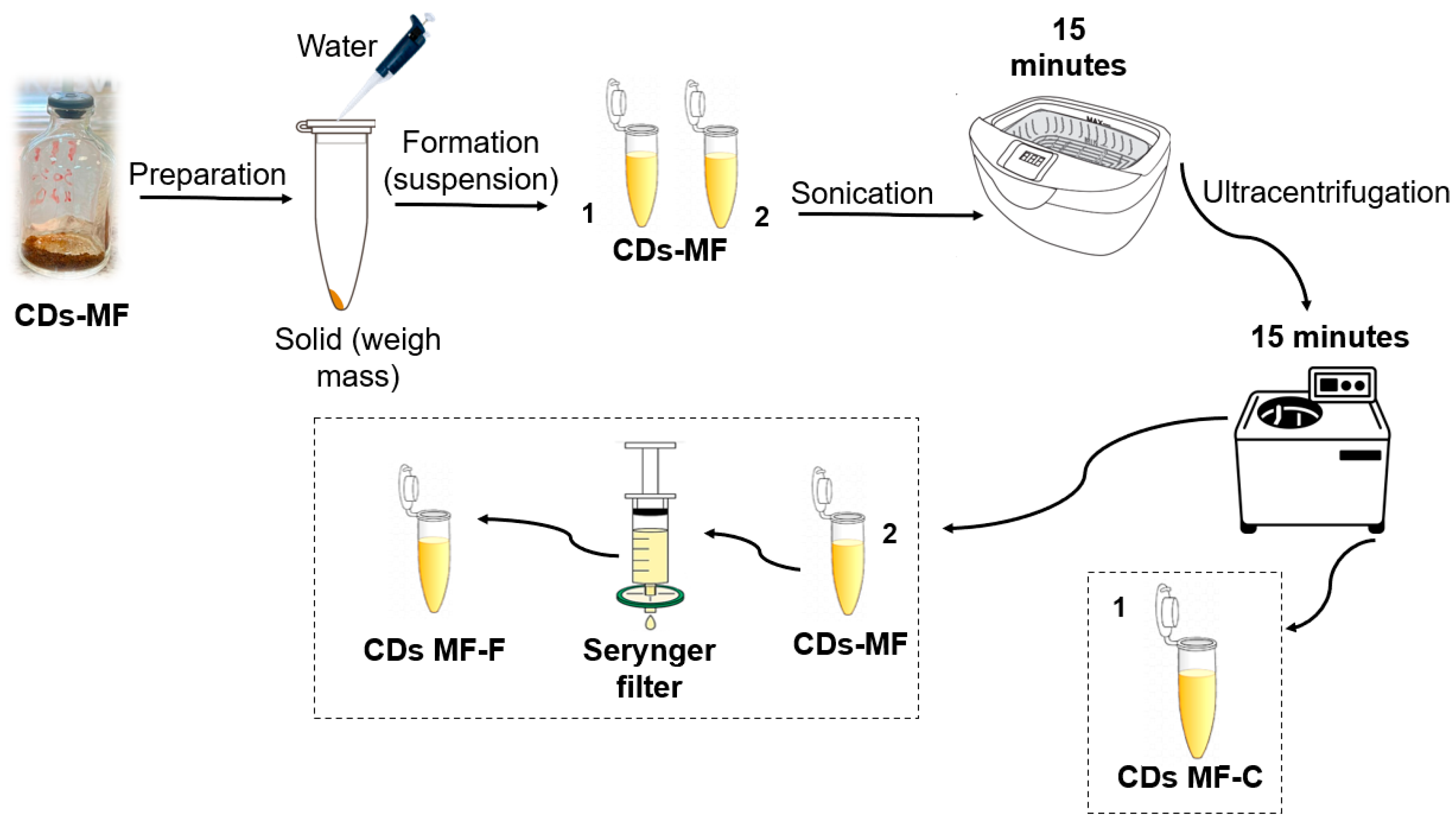



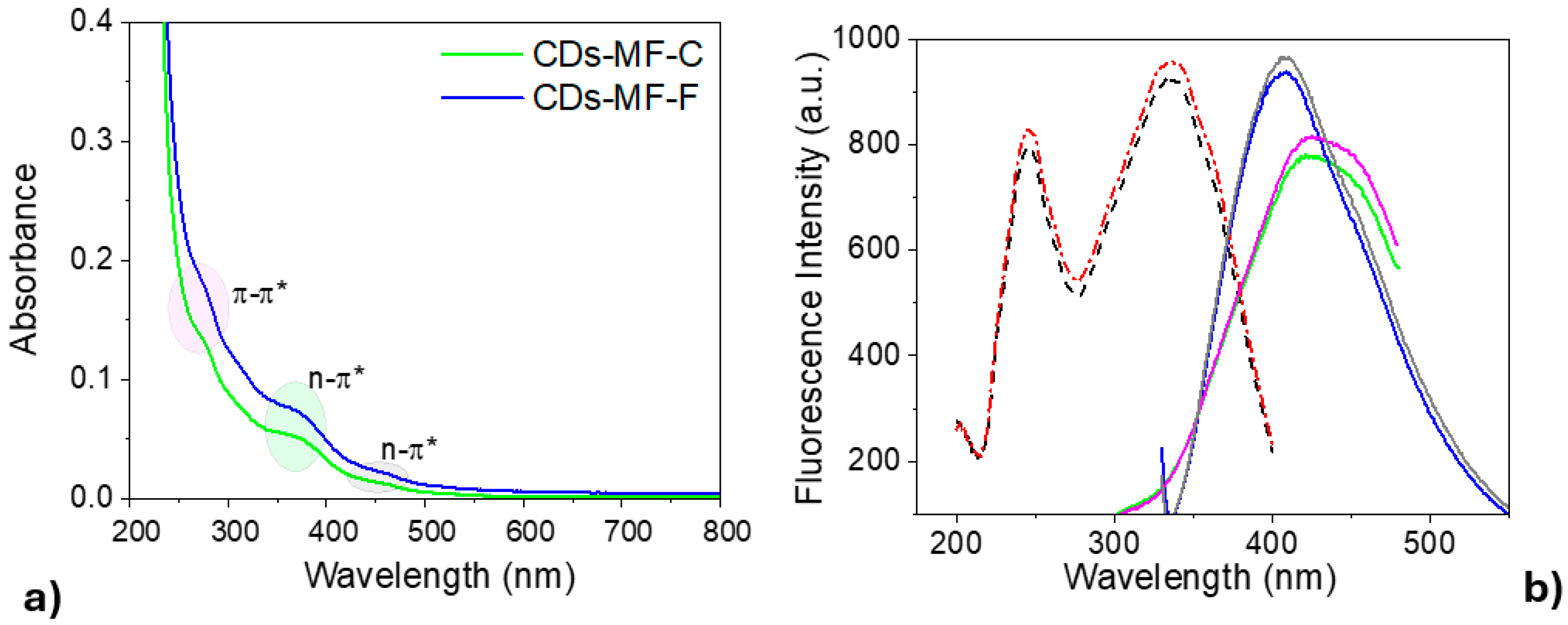
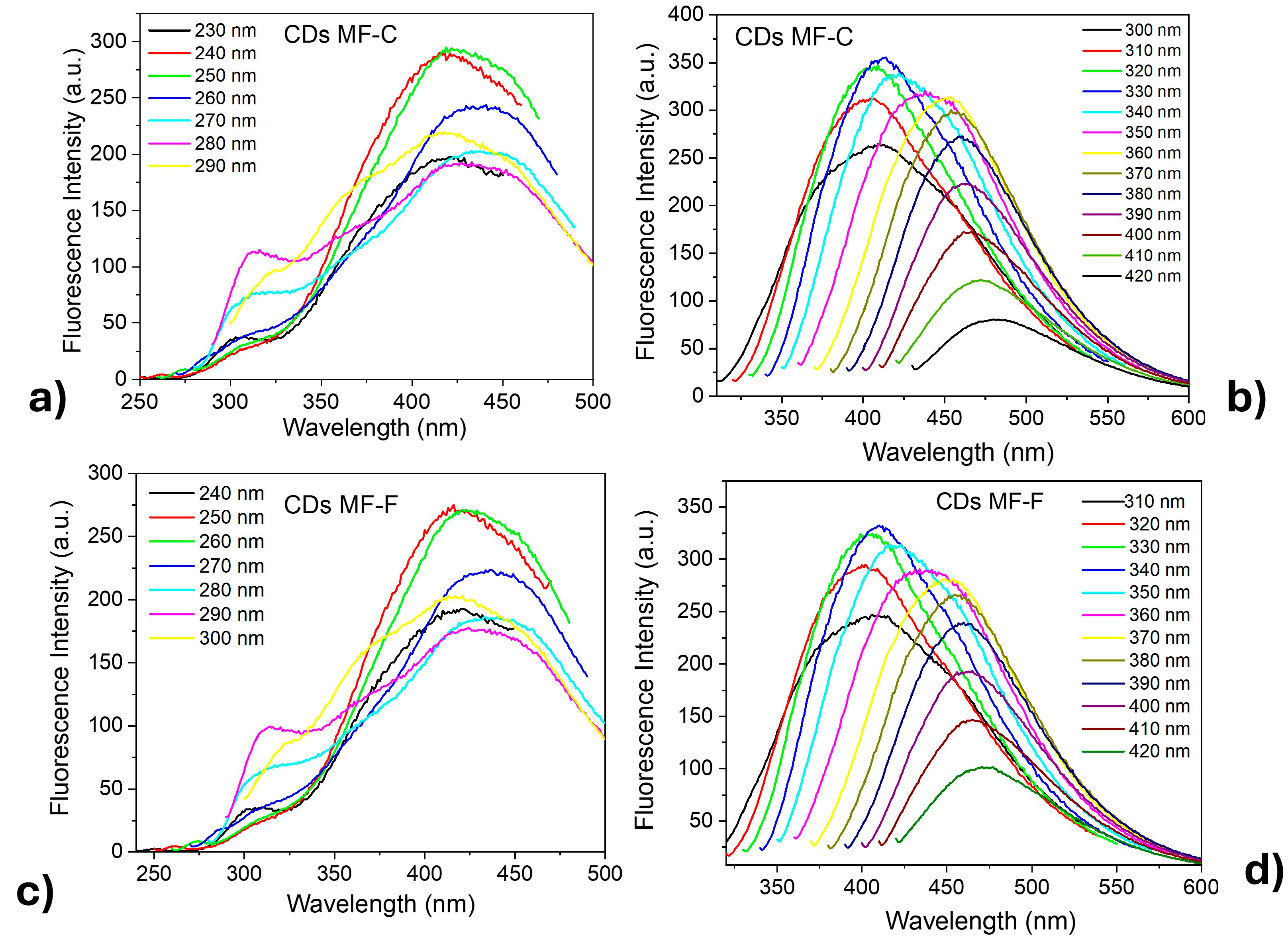

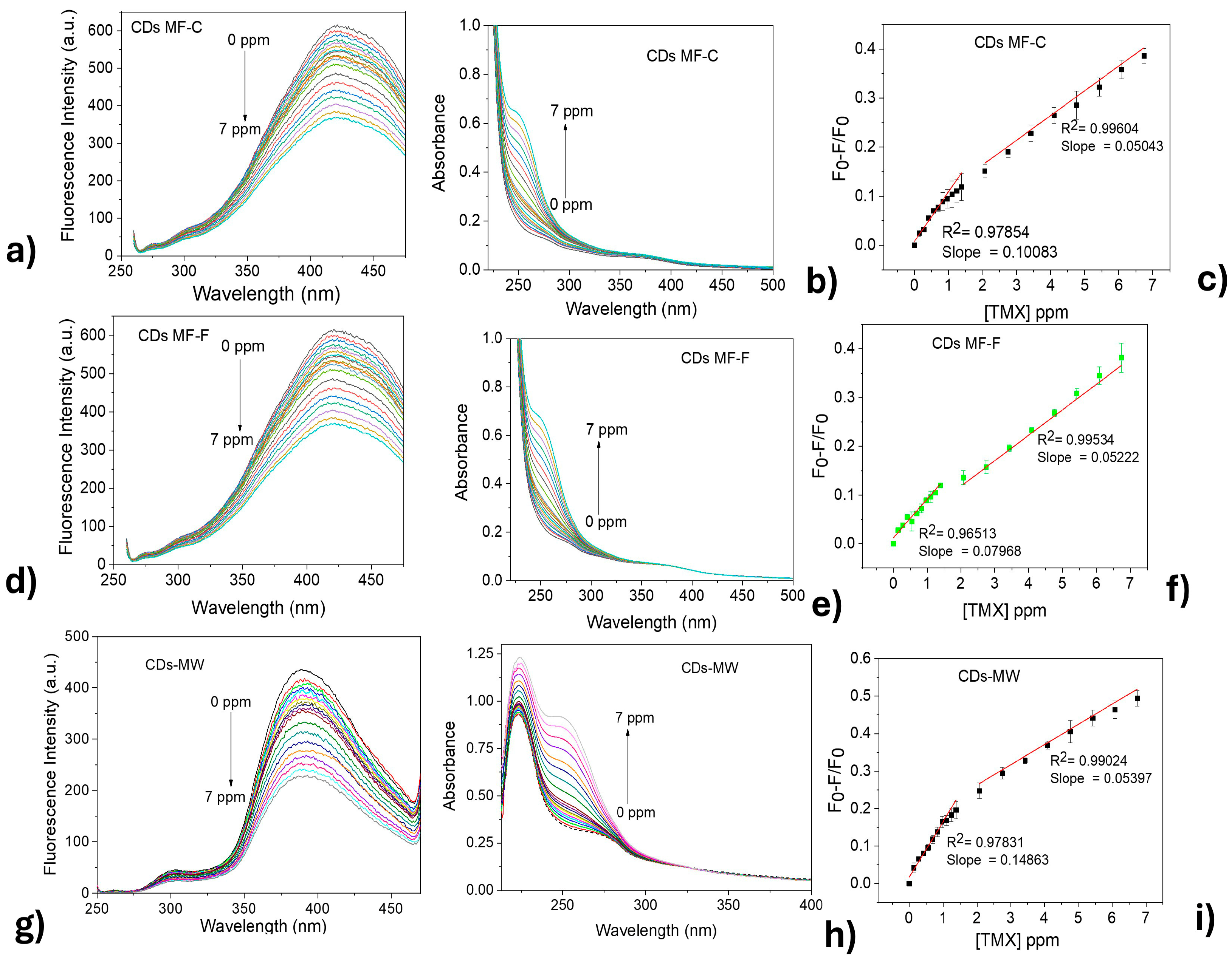
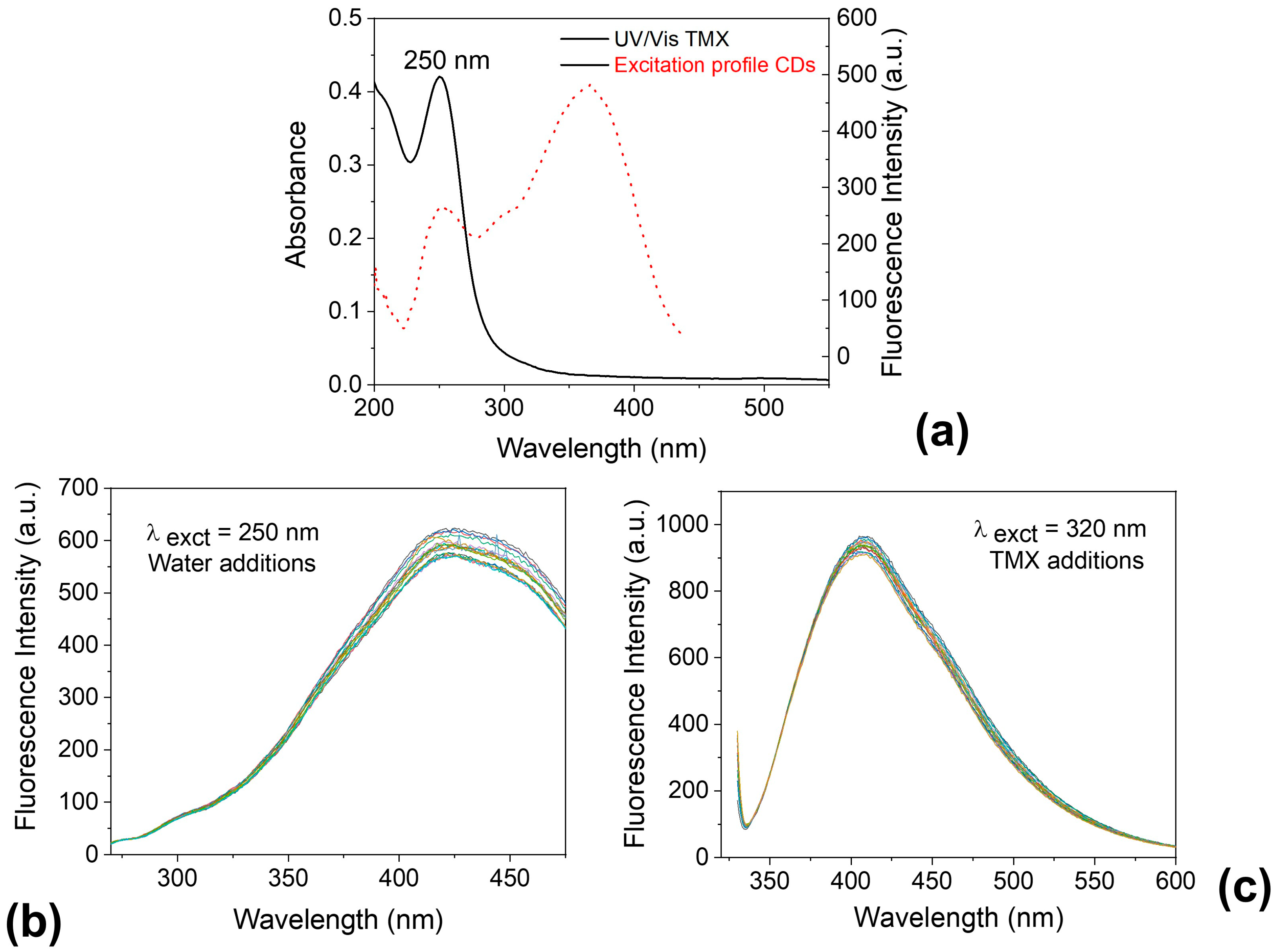
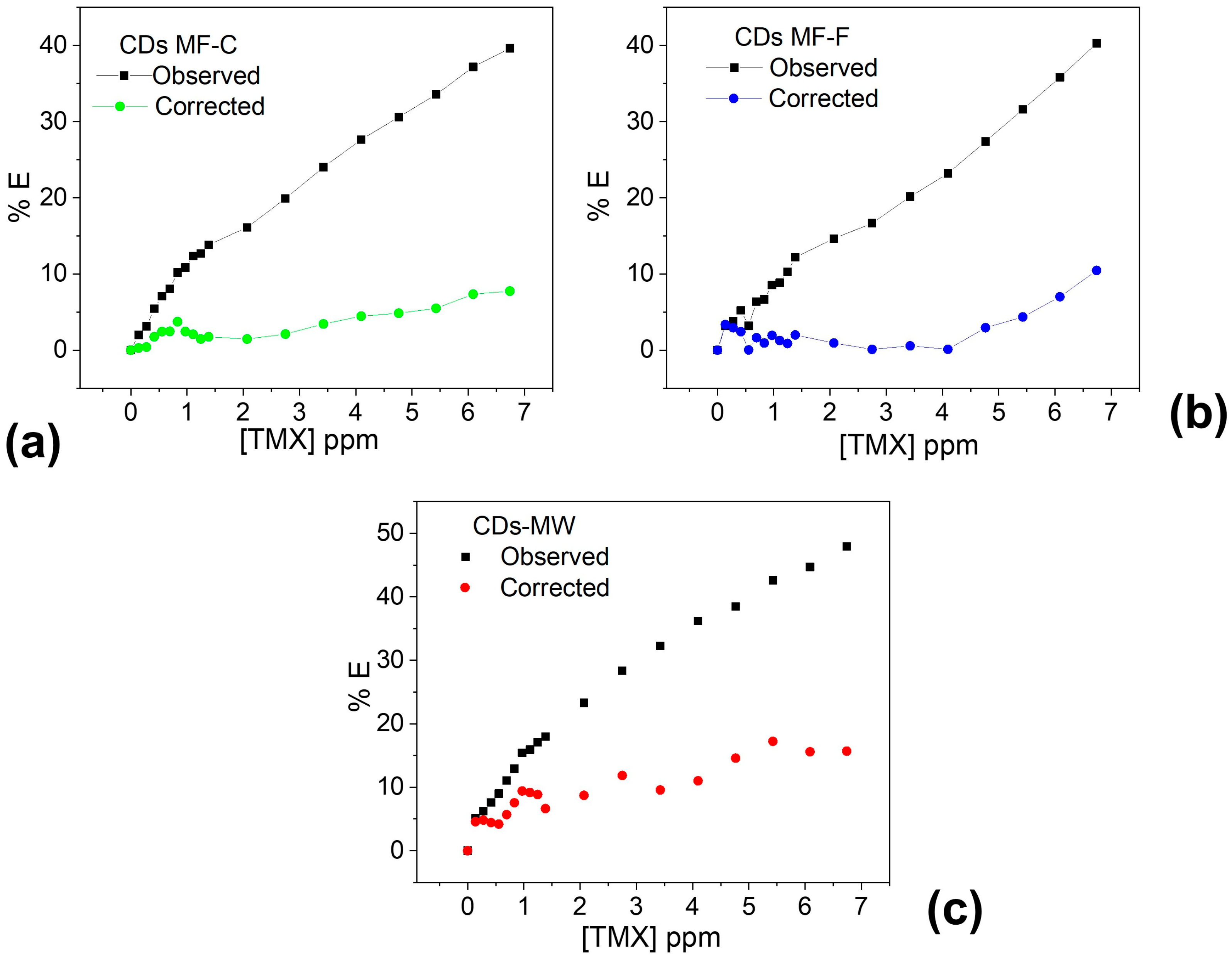
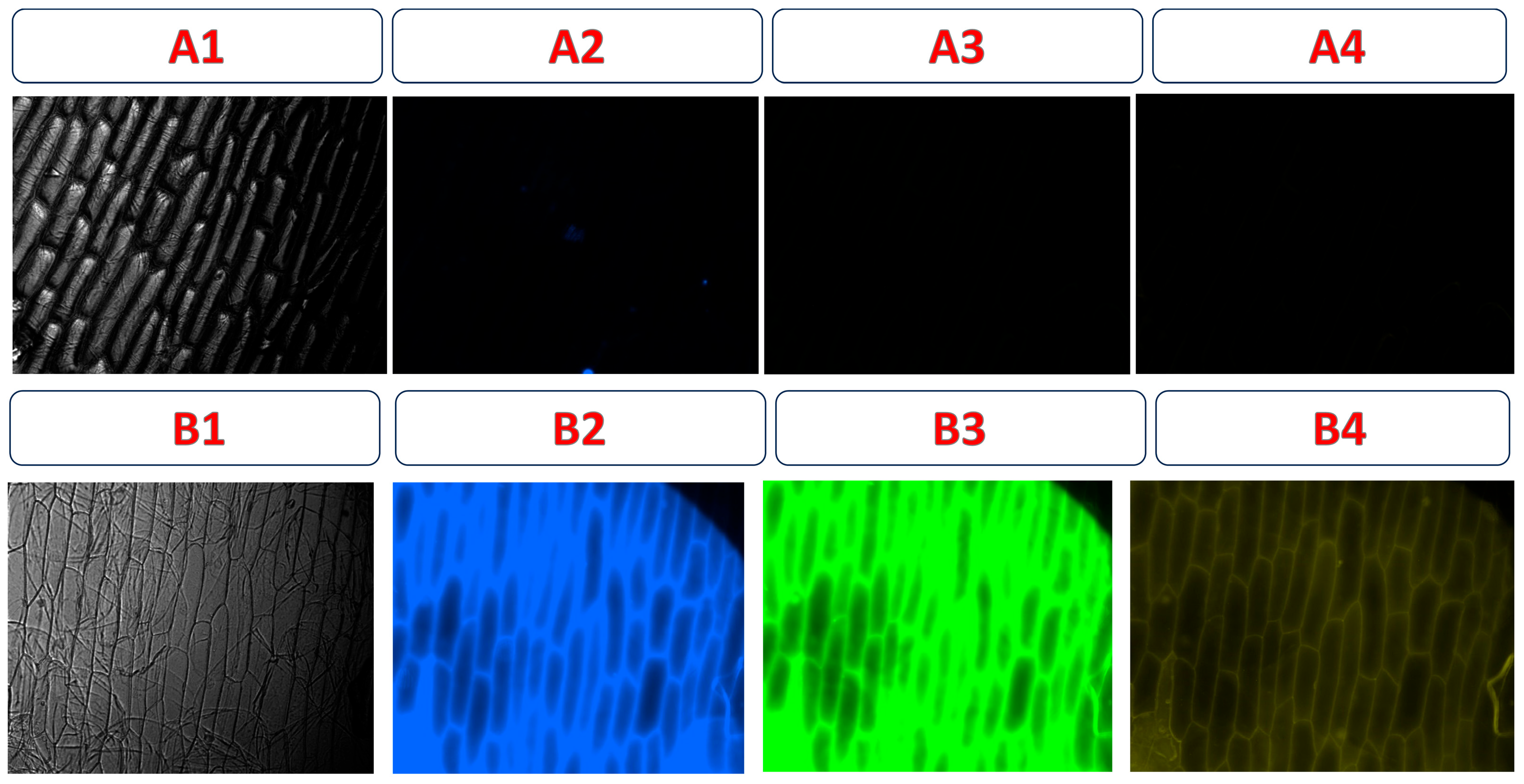
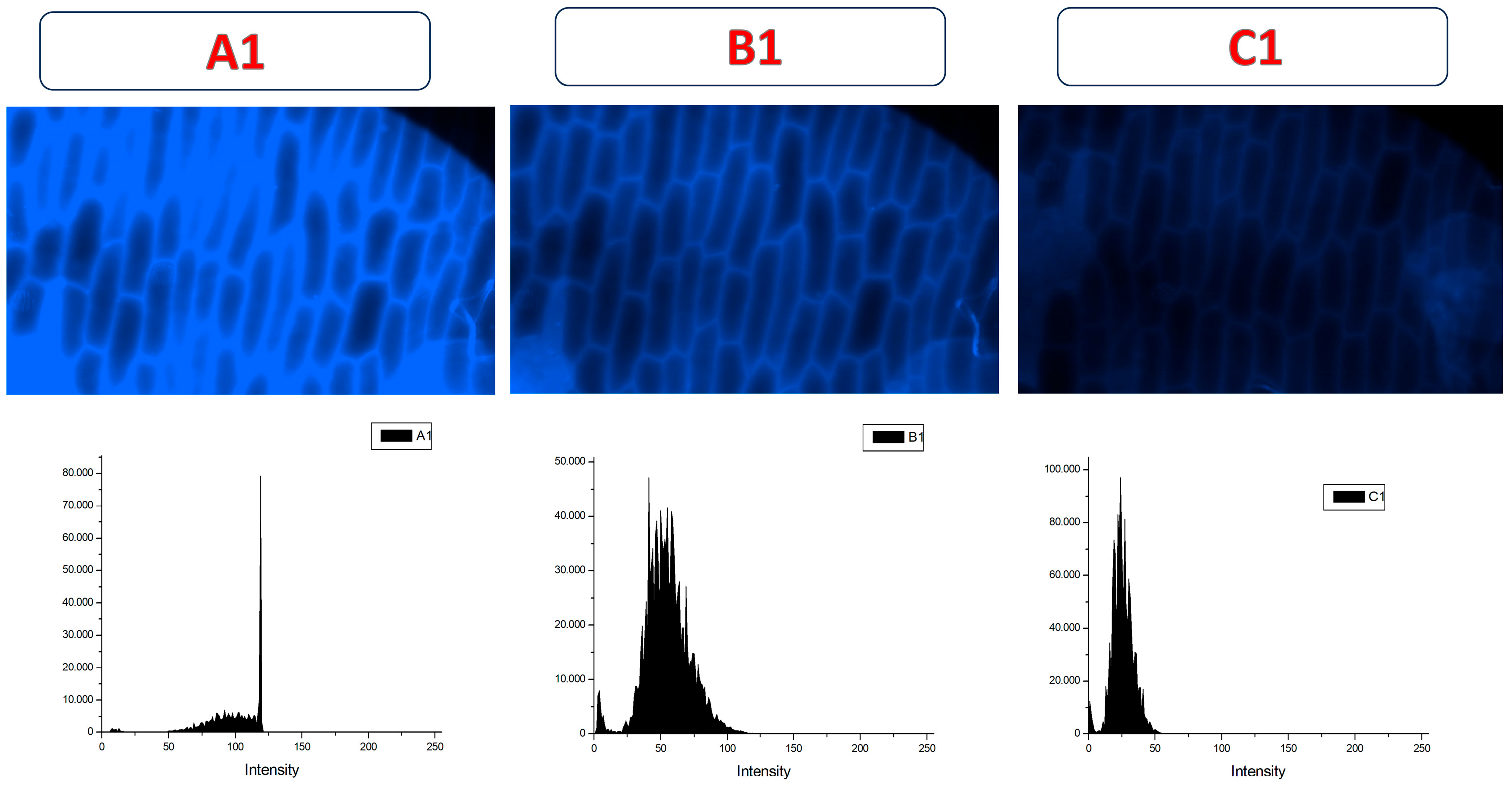
| CDs | T (K) | τ1/ns | τ2/ns | τ3/ns | τAVE/ns | χ2 | kR (s−1) × 107 | kNR (s−1) × 107 | Ref. |
|---|---|---|---|---|---|---|---|---|---|
| MF-C | 298 | 9.52 | 2.83 | 0.51 | 8.30 | 1.09 | 2.65 | 9.40 | This work |
| MF-F | 298 | 9.65 | 2.77 | 0.50 | 7.73 | 1.10 | 3.36 | 9.57 | This work |
| MW | 298 | 7.84 | 2.60 | 0.44 | 3.63 | 1.17 | 2.56 | 82.9 | [39] |
| CDs | [TMX] ppm | LOD (ppm) | LOQ (ppm) | [TMX] ppm | LOD (ppm) | LOQ (ppm) |
|---|---|---|---|---|---|---|
| MF-C | 0–1.384 | 0.194 ± 0.112 | 0.647 ± 0.373 | 2.069–6.740 | 0.396 ± 0.088 | 1.317 ± 0.287 |
| MF-F | 0–1.384 | 0.186 ± 0.057 | 0.622 ± 0.188 | 2.069–6.740 | 0.475 ± 0.160 | 1.585 ± 0.533 |
| MW | 0–1.384 | 0.138 ± 0.033 | 0.445 ± 0.079 | 2.069–6.740 | 0.549 ± 0.033 | 1.831 ± 0.113 |
Disclaimer/Publisher’s Note: The statements, opinions and data contained in all publications are solely those of the individual author(s) and contributor(s) and not of MDPI and/or the editor(s). MDPI and/or the editor(s) disclaim responsibility for any injury to people or property resulting from any ideas, methods, instructions or products referred to in the content. |
© 2025 by the authors. Licensee MDPI, Basel, Switzerland. This article is an open access article distributed under the terms and conditions of the Creative Commons Attribution (CC BY) license (https://creativecommons.org/licenses/by/4.0/).
Share and Cite
Caetano, M.M.; de Lima, R.G. Thiamethoxam Sensing Using Gelatin Carbon Dots: Influence of Synthesis and Purification Methods. Chemosensors 2025, 13, 326. https://doi.org/10.3390/chemosensors13090326
Caetano MM, de Lima RG. Thiamethoxam Sensing Using Gelatin Carbon Dots: Influence of Synthesis and Purification Methods. Chemosensors. 2025; 13(9):326. https://doi.org/10.3390/chemosensors13090326
Chicago/Turabian StyleCaetano, Mayara Martins, and Renata Galvão de Lima. 2025. "Thiamethoxam Sensing Using Gelatin Carbon Dots: Influence of Synthesis and Purification Methods" Chemosensors 13, no. 9: 326. https://doi.org/10.3390/chemosensors13090326
APA StyleCaetano, M. M., & de Lima, R. G. (2025). Thiamethoxam Sensing Using Gelatin Carbon Dots: Influence of Synthesis and Purification Methods. Chemosensors, 13(9), 326. https://doi.org/10.3390/chemosensors13090326






